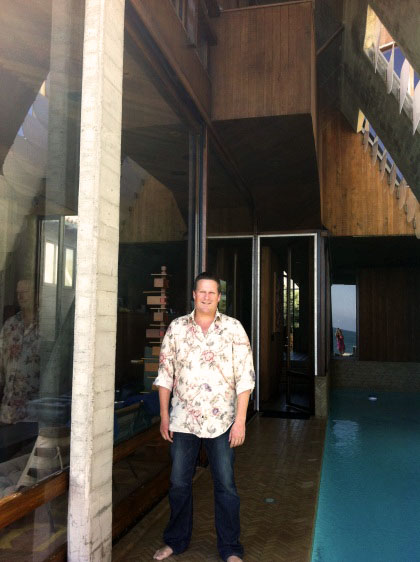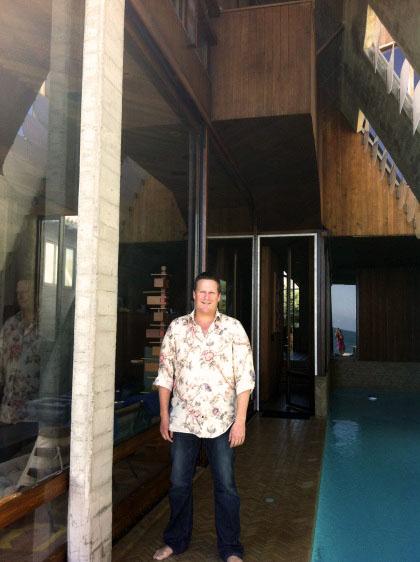This weekend we’re hosting a tribute to architect John Lautner on the occasion of his 100th birthday.
We talked to Michael LaFetra, a preservationist who serves on the board of the Los Angeles Conservancy and owns two Lautner houses, one in Malibu and one on Balboa Island. We asked him what it’s like to live in one of Lautner’s creations.

Michael LaFetra on the deck outside the living room of Lautner's Stevens House in Malibu.
LaFetra: One of the things that’s really interesting is that Lautner would take materials to the absolute limit. Whether it’s concrete, or a piece of floor-to-ceiling glass, he really committed to the material.
LACMA: How did you originally encounter Lautner’s work?
LAFETRA: Initially, I wasn’t a fan of Lautner. When I was first getting interested in architecture I found straight lines, steel beams, and everything exposed very honest and truthful and easy to understand. I had seen photos of the great rooms designed by Lautner, and they photograph beautifully, but I wasn’t sure about the rest of the house. I suspected that the organic architects were less practical.
I went after a Lautner because I was hoping to disprove my theory and learn something. And it turned out that I had been mistaken. I did learn something: I learned that Lautner really cared about the experience of the people who lived in the house. He designed for them.
LACMA: What’s it like to live inside a Lautner house?
LAFETRA: I lived in New York for awhile, and I came to realize that if a space is well designed you don’t need that much square footage. Anything over about 600 sq ft is pretty luxurious. Some people think that architecture is about celebrating the waste of space. My experience is that the great architects use all of the space well. In a large home, you often have rooms you really don’t use at all. In my Lautner house, I end up using every bit of the space.
I love to see the interplay of light against surface materials, to feel the rough texture of concrete and rough-hewn cedar. It’s like living inside art, living inside a sculpture.
When you see the house from the outside, you’re not sure what to expect. Once you enter, you realize that the space is very rational, but it’s also playful. I love that about it. People say it’s like a treehouse, or a boat.
LACMA: How did you research the house and what did you find out?
LAFETRA: I got the drawings for the house from the Lautner Foundation. There were a couple of different schemes for the house. The way the house is set up now, you park, open a gate, and you’re in a courtyard. The house wraps over you as you move toward the front door. His original scheme was to have the kitchen and the dining room there, so you’d walk up three steps into the kitchen and dining room, then you’d walk outside into a courtyard, then you’d cross the courtyard to a separate building that housed the living room and bedrooms.
I remember thinking, that’s interesting! I’d like that! But it would be ground-up construction, rather than a restoration.
LACMA: If you could ask Lautner one question today, what would it be?
LAFETRA: I would ask, did he have a favorite project that he was never able to get built? And I would tackle that. I would love to know what he would have built for himself. There was a mountain house he designed for himself in Three Rivers that never got built. I’d like to know what that space would have been like.
If the only constraint the architect is given is budget, without the demands of a client, sometimes they create really incredible spaces.
LACMA: What else?
LAFETRA: I think he was underappreciated in his lifetime. It can be hard to be an architect; unlike a painter, an architect needs a client in order to create. But a lot of people don’t really know what they want. I think that’s as true today as it was in Lautner’s day. We’re distracted and we don’t really know what we like—but if you pay attention, good design takes root in you. When you feel that, it’s a sign that you’ve encountered something meaningful.
To learn more about Lautner, join us this weekend. On Saturday afternoon, come for a panel discussion and reception with architects and critics Michael Rotondi, Craig Hodgetts and Sylvia Lavin. On Sunday, visit Art Catalogues Bookstore for a talk with artist Dan Graham about Lautner’s legacy.
Amy Heibel



